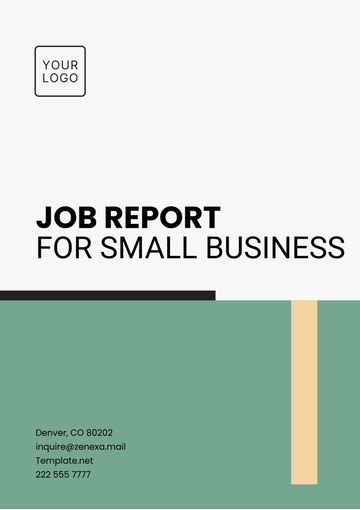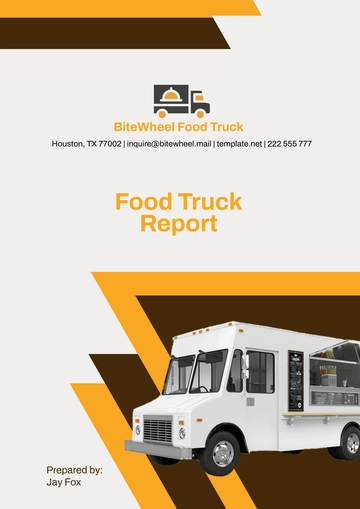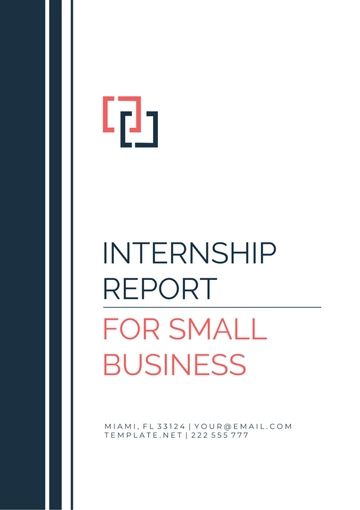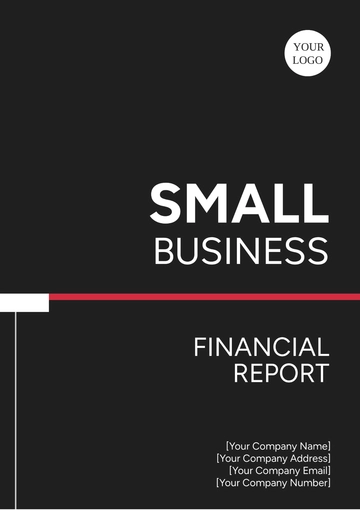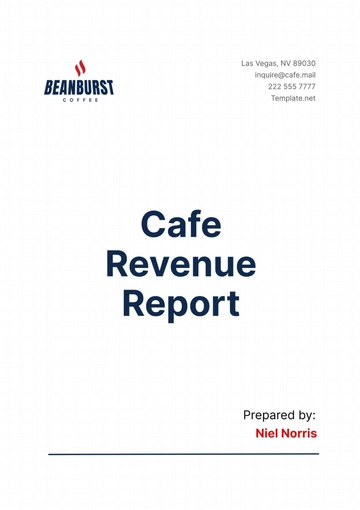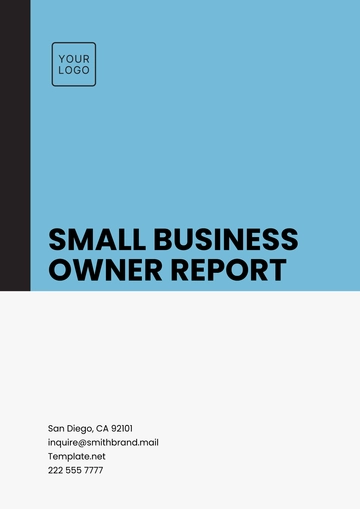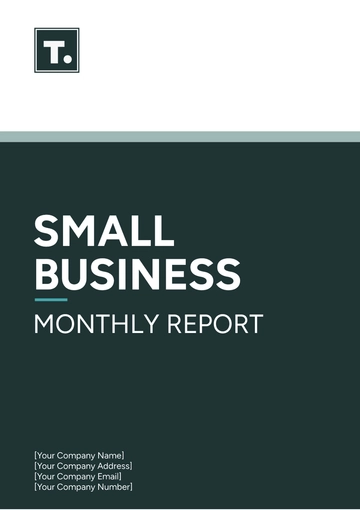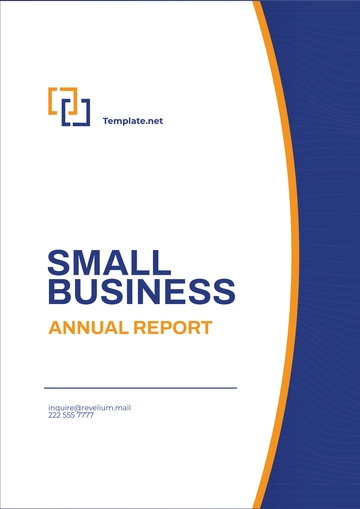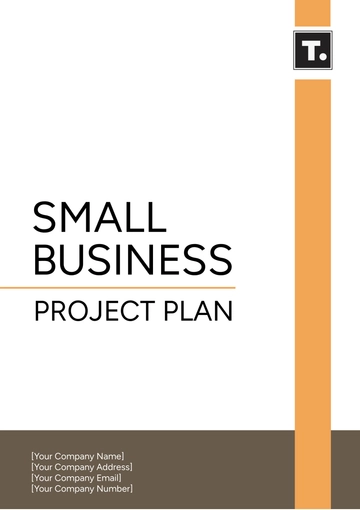Free Cafe Revenue Report
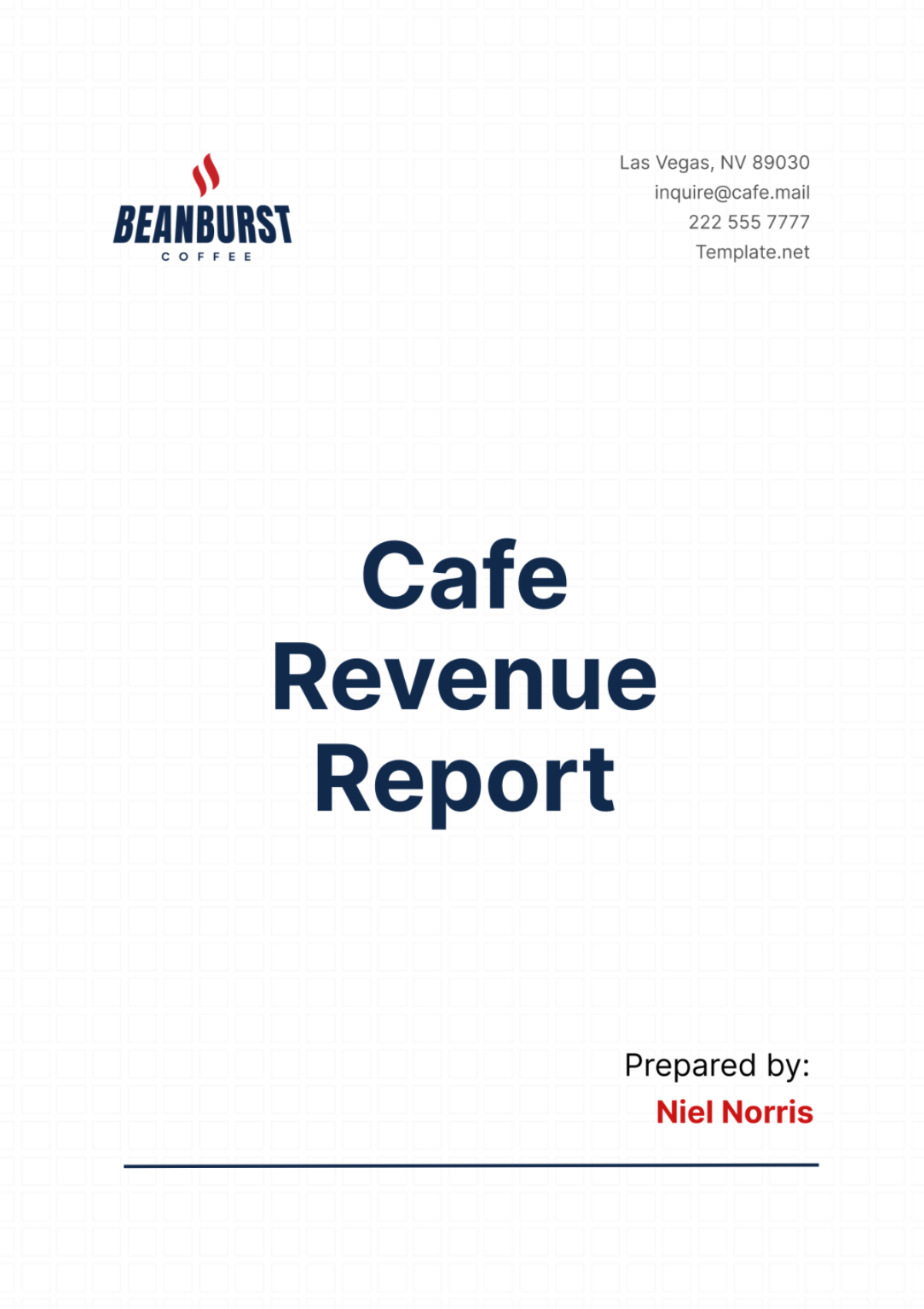
I. Introduction
This Revenue Report provides a detailed analysis of the financial performance of [Your Company Name] for the year 2051. This report aims to offer insights into the revenue trends, customer demographics, marketing campaign effectiveness, and expense management. Understanding these aspects is crucial for developing strategies to enhance profitability and operational efficiency.
A. Purpose of the Report
Financial Analysis: This report provides a comprehensive financial analysis of the cafe's revenue streams throughout the year. By examining monthly and quarterly revenue, we can identify patterns and areas for improvement, enabling better financial planning and forecasting.
Customer Insights: Understanding customer demographics and preferences helps tailor our offerings and marketing strategies. This will delve into the profiles of our customer base, ensuring our services meet their needs and expectations.
Marketing Effectiveness: Evaluating the performance of various marketing campaigns provides insights into their effectiveness and ROI. This helps in planning future campaigns more effectively, ensuring resources are allocated to the most impactful strategies.
B. Scope of the Report
Revenue Breakdown: The report includes a detailed breakdown of monthly and quarterly revenue, highlighting significant trends and seasonal variations. This allows for a better understanding of revenue fluctuations and helps in identifying peak periods and potential growth opportunities.
Expense Analysis: An analysis of monthly expenses provides insights into cost management and potential areas for savings. This part will highlight key expense trends and their impact on profitability, ensuring that costs are controlled and resources are used efficiently.
Strategic Recommendations: Based on the analysis, the report will offer strategic recommendations to enhance revenue growth and improve cost management. These suggestions aim to ensure the long-term success and financial stability of the cafe, providing a roadmap for future improvements.
II. Monthly Revenue Breakdown
The following table presents the monthly revenue for the year 2051:
Month | Revenue |
|---|---|
January | $25,000 |
February | $28,000 |
March | $30,000 |
April | $32,000 |
May | $35,000 |
June | $40,000 |
July | $42,000 |
August | $38,000 |
September | $34,000 |
October | $36,000 |
November | $45,000 |
December | $45,000 |
Total | $380,000 |
A. January - March
January: Revenue for January was $25,000. The start of the year typically sees moderate customer activity as people recover from holiday expenditures. This period requires effective post-holiday marketing to maintain steady sales.
February: February's revenue increased to $28,000, likely due to Valentine’s Day promotions and related events. Special themed offers and promotions attract more customers, boosting sales during this month.
March: In March, revenue rose to $30,000. Spring promotions and increasing customer activity contributed to this growth. It's important to leverage the changing season to introduce new menu items and promotions that resonate with customers.
B. April - June
April: Revenue for April was $32,000. The onset of warmer weather and spring menu items likely boosted sales. This period benefits from marketing outdoor seating and seasonal offerings.
May: May saw a further increase in revenue to $35,000, driven by Mother’s Day promotions and outdoor seating options. Special events and promotions targeting family gatherings can significantly boost sales during this month.
June: In June, revenue peaked at $40,000. Summer promotions and increased foot traffic contributed to this significant rise. Engaging activities and partnerships with local events can drive higher customer engagement and revenue.
C. July - September
July: Revenue reached $42,000 in July, the highest for the year. Summer events and an influx of tourists likely contributed to this peak. This period requires strategic planning of promotions and events to maximize tourist season benefits.
August: Revenue in August was $38,000. While slightly lower than July, summer activities continued to drive strong sales. Maintaining a high level of service and unique offerings can help sustain revenue during this period.
September: In September, revenue was $34,000. The end of summer and back-to-school season typically see a slight decrease in customer activity. Introducing back-to-school promotions and targeting local customers can help mitigate this decline.
D. October - December
October: Revenue for October was $36,000. Fall promotions and Halloween events contributed to steady sales. Seasonal decorations and themed events can enhance customer experience and boost sales.
November: In November, revenue increased significantly to $45,000. Thanksgiving promotions and the start of the holiday season drove this spike. Early holiday promotions and special menu items can attract more customers during this period.
December: December also saw revenue of $45,000, maintaining the high levels due to Christmas and New Year’s Eve celebrations. Offering festive menu items and hosting holiday events can maximize revenue during the holiday season.
The monthly revenue breakdown highlights the impact of seasonal trends and promotional activities on sales. Focusing on high-revenue months and understanding the factors contributing to these peaks can help in planning future strategies.
III. Quarterly Revenue Analysis
The following chart and table summarize the quarterly revenue for 2051:
Quarter | Revenue |
|---|---|
Q1 | $83,000 |
Q2 | $107,000 |
Q3 | $114,000 |
Q4 | $136,000 |
Total | $440,000 |
A. Q1 (January - March)
Revenue: The total revenue for Q1 was $83,000. This period showed steady growth, reflecting successful early-year promotions and customer engagement. Early-year strategies should focus on maintaining momentum from the holiday season.
Insights: Starting the year with strategic promotions and leveraging Valentine’s Day can significantly boost early-year revenue. Implementing targeted campaigns can help attract new customers and retain existing ones.
B. Q2 (April - June)
Revenue: Q2 revenue totaled $107,000. The significant rise from Q1 is attributed to spring and early summer promotions, along with increased customer activity. Effective use of seasonal themes and outdoor events can enhance sales during this period.
Insights: Seasonal menu items and outdoor events can drive higher customer traffic and sales in Q2. Consistent quality and innovative offerings are key to attracting and retaining customers.
C. Q3 (July - September)
Revenue: Q3 had the highest quarterly revenue of $114,000. Summer activities and tourist influx contributed to this peak. This period benefits from maximizing the potential of peak tourist season and offering unique experiences.
Insights: Capitalizing on peak tourist seasons and summer events can maximize revenue during Q3. Strategic partnerships and well-planned promotions are essential to leverage the high customer turnout.
D. Q4 (October - December)
Revenue: Q4 saw the highest revenue at $136,000. The holiday season, with Thanksgiving, Christmas, and New Year’s Eve, significantly boosted sales. Planning ahead for the holiday season is crucial to maximize revenue opportunities.
Insights: Holiday promotions and events are critical for maximizing revenue in Q4. A well-executed holiday strategy can significantly enhance customer engagement and sales.
The quarterly revenue analysis highlights the importance of seasonal trends and strategic promotions in driving sales. Understanding these patterns helps in planning and optimizing marketing efforts.
IV. Revenue by Product Category
The following table details the revenue generated by different product categories:
Product Category | Revenue |
|---|---|
Beverages | $150,000 |
Bakery Items | $90,000 |
Sandwiches and Salads | $80,000 |
Desserts | $60,000 |
Other | $20,000 |
Total | $400,000 |
A. Beverages
Revenue: Beverages generated the highest revenue at $150,000. This category includes coffee, tea, and other drinks, which are core offerings. Ensuring a high-quality and diverse beverage menu is essential to maintain customer interest.
Insights: Focusing on expanding beverage options and introducing seasonal specials can further boost sales in this high-revenue category. Innovative and seasonal drinks can attract new customers and increase repeat visits.
B. Bakery Items
Revenue: Bakery items brought in $90,000. Freshly baked goods such as croissants, muffins, and bread are popular among customers. Consistency in quality and variety can drive sales in this category.
Insights: Offering a variety of fresh, high-quality bakery items can attract more customers and drive higher sales. Seasonal and specialty bakery items can enhance the customer experience and boost sales.
C. Sandwiches and Salads
Revenue: Sandwiches and salads generated $80,000. These items are popular for lunch and quick meals. Offering a range of healthy and diverse options can cater to different customer preferences.
Insights: Expanding the menu with healthy and diverse options can cater to a broader customer base and increase sales. Promoting these items during lunch hours and offering combos can drive higher revenue.
D. Desserts
Revenue: Desserts contributed $60,000 to the total revenue. This category includes cakes, cookies, and other sweet treats. High-quality and visually appealing desserts can attract customers and boost sales.
Insights: Offering high-quality, visually appealing desserts can enhance the customer experience and drive sales. Introducing seasonal and specialty desserts can attract more customers and encourage repeat visits.
E. Other
Revenue: Other items generated $20,000. This category includes miscellaneous items such as snacks and small bites. While not a major revenue driver, these items complement the main offerings and can enhance overall sales.
Insights: Diversifying the menu with complementary items can enhance the overall customer experience and contribute to incremental sales. Promoting these items as add-ons can increase average transaction value.
Analyzing revenue by product category helps identify strengths and areas for improvement. Focusing on popular items and expanding the menu with innovative offerings can drive higher sales.
V. Customer Demographics
The following chart and table present the breakdown of customer demographics:
Age Group | Percentage |
|---|---|
18-25 | 25% |
26-35 | 35% |
36-45 | 20% |
46-60 | 15% |
60+ | 5% |
A. Age 18-25
Demographic: The 18-25 age group makes up 25% of the customer base. These customers are typically students or young professionals looking for affordable and trendy options. Engaging this demographic requires innovative marketing and trendy menu items.
Marketing Strategy: Offering student discounts, promoting on social media, and hosting events can attract this demographic. Trendy, affordable menu items and a vibrant atmosphere are key to retaining these customers.
B. Age 26-35
Demographic: Customers aged 26-35 represent 35% of the customer base, the largest segment. These individuals often seek a mix of quality, convenience, and experience. Marketing to this group should focus on quality offerings and convenience.
Marketing Strategy: Promoting high-quality products, offering convenient online ordering, and hosting professional networking events can attract this demographic. This group values convenience and quality, so maintaining high standards is crucial.
C. Age 36-45
Demographic: The 36-45 age group makes up 20% of the customer base. These customers are often working professionals or parents looking for quality food and a relaxed atmosphere. Creating a family-friendly and professional environment is essential.
Marketing Strategy: Family-friendly promotions, healthy menu options, and comfortable seating can attract this demographic. Highlighting the cafe’s convenience and quality can also drive sales.
D. Age 46-60
Demographic: Customers aged 46-60 represent 15% of the customer base. They typically seek quality and a quiet environment for socializing or working. Providing a comfortable and quiet space is important for this group.
Marketing Strategy: Promoting quality offerings, providing comfortable and quiet spaces, and hosting special events can appeal to this age group. This demographic appreciates a peaceful and quality dining experience.
E. Age 60+
Demographic: The 60+ age group makes up 5% of the customer base. These customers often look for a relaxed environment and value for money. Catering to their preferences can enhance their loyalty and frequent visits.
Marketing Strategy: Offering senior discounts, comfortable seating, and a relaxing atmosphere can attract this demographic. Providing value-for-money options and a calm environment is key to retaining these customers.
Understanding customer demographics helps in tailoring marketing strategies and improving service offerings. Catering to the preferences of each demographic group can enhance customer satisfaction and loyalty.
VI. Marketing Campaign Performance
The following table summarizes the performance of various marketing campaigns throughout the year:
Campaign | Cost | Revenue Generated | ROI |
|---|---|---|---|
Spring Special | $5,000 | $20,000 | 300% |
Summer Promotion | $7,000 | $30,000 | 329% |
Fall Festival | $6,000 | $25,000 | 317% |
Winter Sale | $8,000 | $40,000 | 400% |
A. Spring Special
Campaign Details: The Spring Special campaign cost $5,000 and generated $20,000 in revenue, achieving an ROI of 300%. It focused on promoting new spring menu items and discounts. The campaign effectively attracted customers looking for seasonal offerings.
Insights: The high ROI indicates the campaign was effective in attracting customers. Seasonal promotions can significantly boost revenue when timed correctly. It's important to continue leveraging seasonal trends to maintain customer interest and drive sales.
B. Summer Promotion
Campaign Details: The Summer Promotion campaign had a cost of $7,000 and generated $30,000 in revenue, with an ROI of 329%. This campaign included outdoor events and special summer menu items. Engaging activities and promotions helped attract a large customer base.
Insights: The success of this campaign highlights the importance of leveraging peak tourist seasons. Engaging activities and seasonal offerings can drive high customer turnout and sales. Planning for summer promotions should include diverse and exciting events to attract both locals and tourists.
C. Fall Festival
Campaign Details: The Fall Festival campaign cost $6,000 and brought in $25,000 in revenue, achieving an ROI of 317%. It featured themed events and autumn-inspired menu items. The campaign effectively utilized the fall season to attract customers.
Insights: The positive ROI shows that themed events and seasonal promotions can effectively attract customers. Continually updating the menu with seasonal items keeps the offerings fresh and exciting. Fall-themed promotions should focus on creating a warm and cozy atmosphere to attract more customers.
D. Winter Sale
Campaign Details: The Winter Sale campaign cost $8,000 and generated $40,000 in revenue, with an ROI of 400%. This campaign focused on holiday promotions and discounts. The high customer turnout during the holiday season significantly boosted sales.
Insights: The highest ROI among the campaigns indicates the strong impact of holiday promotions. Special deals and holiday-themed offerings can drive substantial sales during the winter season. Planning for winter promotions should include festive and attractive discounts to maximize revenue.
Evaluating marketing campaign performance helps in understanding what works best for the cafe. Effective campaigns can significantly boost revenue, and insights from past campaigns guide future marketing strategies.
VII. Expense Analysis
The following table presents the monthly expenses for the year 2051:
Month | Expenses |
|---|---|
January | $15,000 |
February | $14,000 |
March | $16,000 |
April | $18,000 |
May | $17,000 |
June | $19,000 |
July | $20,000 |
August | $18,000 |
September | $17,000 |
October | $18,000 |
November | $21,000 |
December | $22,000 |
Total | $215,000 |
A. January - March
January: Expenses for January were $15,000. Initial start-of-year costs included inventory replenishment and minor maintenance. These expenses were necessary to prepare for the year ahead.
February: February saw a slight decrease in expenses to $14,000. Efficient management of resources contributed to lower costs. This month focused on maintaining operational efficiency without incurring high expenses.
March: In March, expenses rose to $16,000. Increased marketing efforts and preparation for the spring season accounted for this rise. Investing in marketing during this period helped attract more customers.
B. April - June
April: Expenses for April were $18,000. Increased costs were due to seasonal menu changes and promotional activities. These investments aimed to drive higher customer engagement and sales.
May: May's expenses were $17,000. Efficient inventory management helped in controlling costs while maintaining quality. Keeping inventory costs in check without compromising on quality was crucial.
June: In June, expenses peaked at $19,000. Higher operational costs during the busy summer season contributed to this increase. Preparing for the peak season required additional resources.
C. July - September
July: Expenses reached $20,000 in July, the highest for the summer. Increased staffing and promotional activities for the peak season drove up costs. Ensuring adequate staff and engaging promotions were essential for this busy period.
August: In August, expenses decreased to $18,000. Efficient management of summer activities helped control costs. Maintaining high service levels while optimizing resources was key.
September: Expenses for September were $17,000. The end of the busy season allowed for some reduction in operational costs. Adjusting expenses according to seasonal demand helped in cost management.
D. October - December
October: Expenses for October were $18,000. Preparations for the holiday season began, increasing costs slightly. Early planning for the holiday season ensured a smooth transition into the busy period.
November: November saw expenses rise to $21,000. Holiday preparations and promotions accounted for the increase. Investing in holiday promotions helped drive higher customer turnout.
December: December had the highest expenses at $22,000. Increased staffing, inventory, and promotional activities during the holiday season drove costs up. Ensuring a high level of service during the peak season required additional resources.
Understanding expense trends throughout the year helps in identifying areas for cost management. Efficient resource management and strategic planning are essential for controlling costs while maintaining quality.
VIII. Recommendations
Based on the analysis, the following recommendations aim to enhance revenue growth and improve operational efficiency:
A. Enhance Marketing Strategies
Seasonal Promotions: Continue leveraging seasonal trends with targeted promotions. This strategy has proven effective in driving sales and attracting customers. Innovative and timely promotions can enhance customer engagement and boost revenue.
Social Media Engagement: Increase social media presence and engagement. Platforms like Instagram and Facebook are essential for reaching a broader audience. Consistent and creative content can attract more followers and customers.
Loyalty Programs: Implement loyalty programs to retain customers. Offering rewards and discounts to repeat customers can enhance customer loyalty. A well-structured loyalty program can drive higher customer retention and sales.
B. Optimize Menu Offerings
Expand Beverage Options: Introduce new and innovative beverages regularly. Keeping the beverage menu fresh and exciting can attract more customers. Seasonal drinks and limited-time offers can boost sales.
Healthy Menu Options: Offer more healthy and diverse menu items. Catering to health-conscious customers can increase the customer base. Highlighting healthy options in promotions can attract a broader audience.
Specialty Items: Introduce specialty items that cater to different customer preferences. Offering unique and high-quality items can differentiate the cafe from competitors. Specialty items can attract new customers and encourage repeat visits.
C. Improve Operational Efficiency
Inventory Management: Enhance inventory management practices to reduce waste and control costs. Efficient inventory practices can ensure resource optimization. Regular inventory audits can help maintain quality and reduce unnecessary expenses.
Staff Training: Invest in regular staff training to improve service quality. Well-trained staff can enhance the customer experience and drive higher satisfaction. Continuous training ensures consistent service standards.
Cost Control: Implement cost control measures to manage expenses effectively. Identifying areas for cost savings can enhance profitability. Strategic cost management ensures resources are used efficiently.
D. Customer Engagement
Feedback Mechanisms: Implement customer feedback mechanisms to gather insights. Customer feedback helps identify areas for improvement and enhance service quality. Regularly reviewing feedback can drive continuous improvement.
Community Involvement: Engage with the local community through events and partnerships. Community involvement can enhance the cafe’s reputation and attract more customers. Building strong community relationships can drive long-term success.
Personalized Marketing: Use personalized marketing strategies to cater to different customer preferences. Tailored promotions and offers can enhance customer engagement. Personalized marketing ensures customers feel valued and appreciated.
Implementing these recommendations can drive higher revenue growth and improve operational efficiency. Strategic planning and continuous improvement are essential for the long-term success of the cafe.
IX. Conclusion
The Revenue Report of [Your Company Name] for the year 2051 provides a comprehensive analysis of financial performance, customer demographics, marketing effectiveness, and expense management. Understanding these aspects is crucial for developing strategies to enhance profitability and operational efficiency.
The report highlights significant trends in monthly and quarterly revenue, demonstrating the impact of seasonal variations and promotional activities. The analysis of product categories and customer demographics provides valuable insights into customer preferences and behavior. Evaluating marketing campaigns and expense trends helps identify areas for improvement and optimization.
Based on the data, several strategic recommendations have been made to enhance revenue growth and operational efficiency. Implementing these strategies can drive higher profitability and ensure the long-term success of the cafe.
Overall, this report serves as a valuable tool for understanding the financial performance of [Your Company Name] and guiding future strategies. Continuous improvement and strategic planning are essential for maintaining a competitive edge and achieving sustained growth.
- 100% Customizable, free editor
- Access 1 Million+ Templates, photo’s & graphics
- Download or share as a template
- Click and replace photos, graphics, text, backgrounds
- Resize, crop, AI write & more
- Access advanced editor
Track financial performance with ease with the Cafe Revenue Report Template! This detailed report only here on Template.net is customizable to fit your cafe's specific reporting needs. Its editable design makes it easy to update regularly. The advanced AI Editor Tool streamlines the process, ensuring accurate and comprehensive financial reporting!
You may also like
- Sales Report
- Daily Report
- Project Report
- Business Report
- Weekly Report
- Incident Report
- Annual Report
- Report Layout
- Report Design
- Progress Report
- Marketing Report
- Company Report
- Monthly Report
- Audit Report
- Status Report
- School Report
- Reports Hr
- Management Report
- Project Status Report
- Handover Report
- Health And Safety Report
- Restaurant Report
- Construction Report
- Research Report
- Evaluation Report
- Investigation Report
- Employee Report
- Advertising Report
- Weekly Status Report
- Project Management Report
- Finance Report
- Service Report
- Technical Report
- Meeting Report
- Quarterly Report
- Inspection Report
- Medical Report
- Test Report
- Summary Report
- Inventory Report
- Valuation Report
- Operations Report
- Payroll Report
- Training Report
- Job Report
- Case Report
- Performance Report
- Board Report
- Internal Audit Report
- Student Report
- Monthly Management Report
- Small Business Report
- Accident Report
- Call Center Report
- Activity Report
- IT and Software Report
- Internship Report
- Visit Report
- Product Report
- Book Report
- Property Report
- Recruitment Report
- University Report
- Event Report
- SEO Report
- Conference Report
- Narrative Report
- Nursing Home Report
- Preschool Report
- Call Report
- Customer Report
- Employee Incident Report
- Accomplishment Report
- Social Media Report
- Work From Home Report
- Security Report
- Damage Report
- Quality Report
- Internal Report
- Nurse Report
- Real Estate Report
- Hotel Report
- Equipment Report
- Credit Report
- Field Report
- Non Profit Report
- Maintenance Report
- News Report
- Survey Report
- Executive Report
- Law Firm Report
- Advertising Agency Report
- Interior Design Report
- Travel Agency Report
- Stock Report
- Salon Report
- Bug Report
- Workplace Report
- Action Report
- Investor Report
- Cleaning Services Report
- Consulting Report
- Freelancer Report
- Site Visit Report
- Trip Report
- Classroom Observation Report
- Vehicle Report
- Final Report
- Software Report
